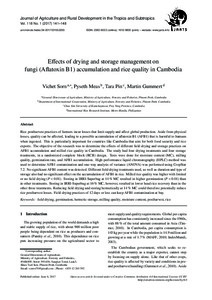Aufsatz

Effects of drying and storage management on fungi (Aflatoxin B1) accumulation and rice quality in Cambodia
Zusammenfassung
Rice postharvest practices of farmers incur losses that limit supply and affect global production. Aside from physical losses, quality can be affected, leading to a possible accumulation of aflatoxin B1 (AFB1) that is harmful to humans when ingested. This is particularly important for countries like Cambodia that aim for both food security and rice exports. The objective of the research was to determine the effects of different field drying and storage practices on AFB1 accumulation and milled rice quality in Cambodia. The study had four drying treatments and four storage treatments, in a randomized complete block (RCB) design. Tests were done for moisture content (MC), milling quality, germination rate, and AFB1 accumulation. High-performance liquid chromatography (HPLC) method was used to determine AFB1 contamination and one-way analysis of variance (ANOVA) was performed using CropStat 7.2. No significant AFB1 content was detected. Different field drying treatments used, as well as duration and type of storage also had no significant effect on the accumulation of AFB1 in rice. Milled rice quality was higher with limited or no field drying (P<0.01). Storing in IRRI-Superbag at 14% MC resulted in higher germination (P<0.01) than in other treatments. Storing in IRRI-Superbag at 16% MC, however, resulted in lower head rice recovery than in the other three treatments. Reducing field drying and storing hermetically at 14% MC could therefore potentially reduce rice postharvest losses. Field drying practices of 12 days or less can keep AFB1 contamination at bay.
Zitierform
In: Journal of Agriculture and Rural Development in the Tropics and Subtropics. Kassel : Kassel University Press. - Vol. 118, No. 1 (2017) S. 141-148Sammlung(en)
Vol 118, No 1 (2017) (Journal of Agriculture and Rural Development in the Tropics and Subtropics (JARTS))Zitieren
@article{urn:nbn:de:hebis:34-2017031552255,
author={Sorn, Vichet and Meas, Pyseth and Pin, Tara and Gummert, Martin},
title={Effects of drying and storage management on fungi (Aflatoxin B1) accumulation and rice quality in Cambodia},
year={2017}
}
0500 Oax 0501 Text $btxt$2rdacontent 0502 Computermedien $bc$2rdacarrier 1100 2017$n2017 1500 1/eng 2050 ##0##urn:nbn:de:hebis:34-2017031552255 3000 Sorn, Vichet 3010 Meas, Pyseth 3010 Pin, Tara 3010 Gummert, Martin 4000 Effects of drying and storage management on fungi (Aflatoxin B1) accumulation and rice quality in Cambodia / Sorn, Vichet 4030 4060 Online-Ressource 4085 ##0##=u http://nbn-resolving.de/urn:nbn:de:hebis:34-2017031552255=x R 4204 \$dAufsatz 4170 7136 ##0##urn:nbn:de:hebis:34-2017031552255
<resource xsi:schemaLocation="http://datacite.org/schema/kernel-2.2 http://schema.datacite.org/meta/kernel-2.2/metadata.xsd"> 2017-06-08T07:21:07Z 2017-06-08T07:21:07Z 2017-06-06 1612-9830 2363-6033 urn:nbn:de:hebis:34-2017031552255 http://hdl.handle.net/123456789/2017031552255 eng Kassel University Press Urheberrechtlich geschützt https://rightsstatements.org/page/InC/1.0/ field drying germination hermetic storage milling quality moisture content postharvest rice 630 Effects of drying and storage management on fungi (Aflatoxin B1) accumulation and rice quality in Cambodia Aufsatz Rice postharvest practices of farmers incur losses that limit supply and affect global production. Aside from physical losses, quality can be affected, leading to a possible accumulation of aflatoxin B1 (AFB1) that is harmful to humans when ingested. This is particularly important for countries like Cambodia that aim for both food security and rice exports. The objective of the research was to determine the effects of different field drying and storage practices on AFB1 accumulation and milled rice quality in Cambodia. The study had four drying treatments and four storage treatments, in a randomized complete block (RCB) design. Tests were done for moisture content (MC), milling quality, germination rate, and AFB1 accumulation. High-performance liquid chromatography (HPLC) method was used to determine AFB1 contamination and one-way analysis of variance (ANOVA) was performed using CropStat 7.2. No significant AFB1 content was detected. Different field drying treatments used, as well as duration and type of storage also had no significant effect on the accumulation of AFB1 in rice. Milled rice quality was higher with limited or no field drying (P<0.01). Storing in IRRI-Superbag at 14% MC resulted in higher germination (P<0.01) than in other treatments. Storing in IRRI-Superbag at 16% MC, however, resulted in lower head rice recovery than in the other three treatments. Reducing field drying and storing hermetically at 14% MC could therefore potentially reduce rice postharvest losses. Field drying practices of 12 days or less can keep AFB1 contamination at bay. open access In: Journal of Agriculture and Rural Development in the Tropics and Subtropics. Kassel : Kassel University Press. - Vol. 118, No. 1 (2017) S. 141-148 Sorn, Vichet Meas, Pyseth Pin, Tara Gummert, Martin Gedruckte Ausg. im Verlag Kassel Univ. Press (www.upress.uni-kassel.de) erschienen. </resource>
Die folgenden Lizenzbestimmungen sind mit dieser Ressource verbunden:
Urheberrechtlich geschützt

